
by Ray Bodrey | Mar 20, 2017
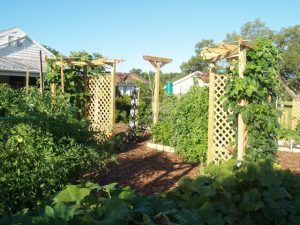
Figure 1: Edible Landscaping.
Credit: Dr. Gail Hansen, Environmental Horticulture-UF/IFAS
Edible landscaping has become a trend for many gardening enthusiasts. A combination of edible plants along with traditional ornamentals can create an artful presentation. There are some challenges when designing such a landscape, but in those challenges opportunities’ may be found. One of the most difficult challenges is making sure your garden or landscape is healthy and vibrant year-round since many edibles are short-lived annuals. These include plants such as eggplant, pepper, lettuce, artichoke and some annual herbs. There is a solution to this concern. First, know your edible plant’s propagation and maturity months. This way you can offset plantings to ensure color in your landscape. Another key measure is to mix some evergreen ornamentals in with short season edibles and long season edibles. Examples of long season edibles include berry shrubs, fruit trees and biennial or perennial herbs.
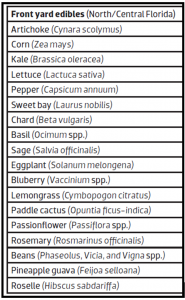
Table 1: North/Central Florida Front Yard Edibles.
Credit: Dr. Gail Hansen, Environmental Horticulture-UF/IFAS.
When designing your edible landscape, think about style and theme to help guide you through the process. A formal design has more straight edges and geometric shapes, whereas the more natural approach has meandering edges and irregular shapes. A color scheme in harmony is very important. Remember, an edible landscape should not just be a production food garden but a visual treat. The goal is not to grow a high yield garden, but only to produce supplemental edibles to make the endeavor worthwhile.
Dr. Gail Hansen, Associate Professor of Environmental Horticulture at the University of Florida, has developed twelve ideas when creating an edible landscape:
- Combine reliable, low-maintenance ornamental with edible plants. Use evergreen ornamentals to maintain enough green structure, so that potential cool season bare spots are not visual.
- Use support structures for an artistic effect and to assist in growth of some plants. Trellises, arbors and even tomato cages are some examples that can be used.
- Use containers in areas to keep the landscape more organized. Planters will also help in maintenance, as plants will be easier to reach and the soil will be easier to manage.
- Create some hard edges in your landscape. Raised beds, garden walls and borders will give defining lines to the landscape and promote a clean appearance.
- A pathway through the landscape will both provide an access to plants and give an inviting appeal. Brick pavers, gravel and mulch are good examples of pathway material.
- Remember color is key. Create a visually pleasing combination of plant color, form, texture and sizes.
- Always start by keeping it simple. So, start small and simple. Then, you can begin filling in the landscape.
- Look for one unique feature to create an added interest to you landscape and provide growth to plants. This could be a shade house for ferns and other hanging baskets or a hay bale, where lettuce, tomatoes or peppers could grow upon.
- Select appealing and easy to grow plants that you want to eat!
- Let plants reach maturity before taking them out of the landscape. For example, rainbow chard will grow larger, if allowed to continue to grow after seed has been produced.
- Use the Florida-Friendly Landscaping principle, “Right Plant, Right Place”, when adding edibles to your landscape. Match the growing needs with the most suitable location.
- Consider your location and layout for irrigation. All plants need some degree of water. An above ground drip irrigation system is usually the most flexible and adjustable irrigation method in regards to overall plant watering needs in a landscape.
Following Dr. Hansen’s ideas will help you create the edible landscape of your dreams. For more information on edible landscaping, please contact your local county extension office for more details.
Supporting information for this article can be found in the UF/IFAS EDIS Publications, “Landscape Design with Edibles” by Dr. Gail Hansen: http://edis.ifas.ufl.edu/pdffiles/EP/EP47500.pdf
UF/IFAS Extension is an Equal Opportunity Institution.
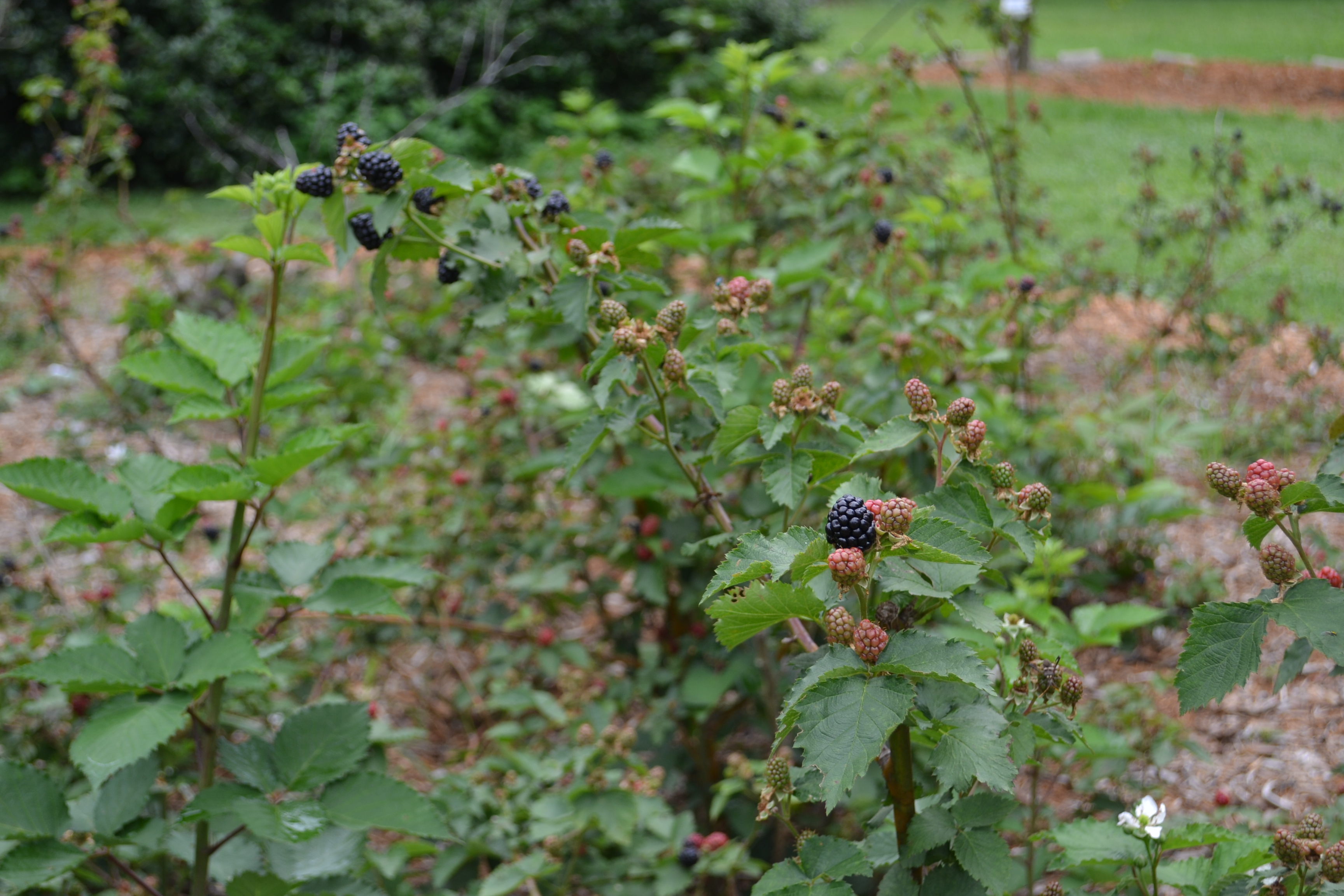
by Beth Bolles | Feb 14, 2017
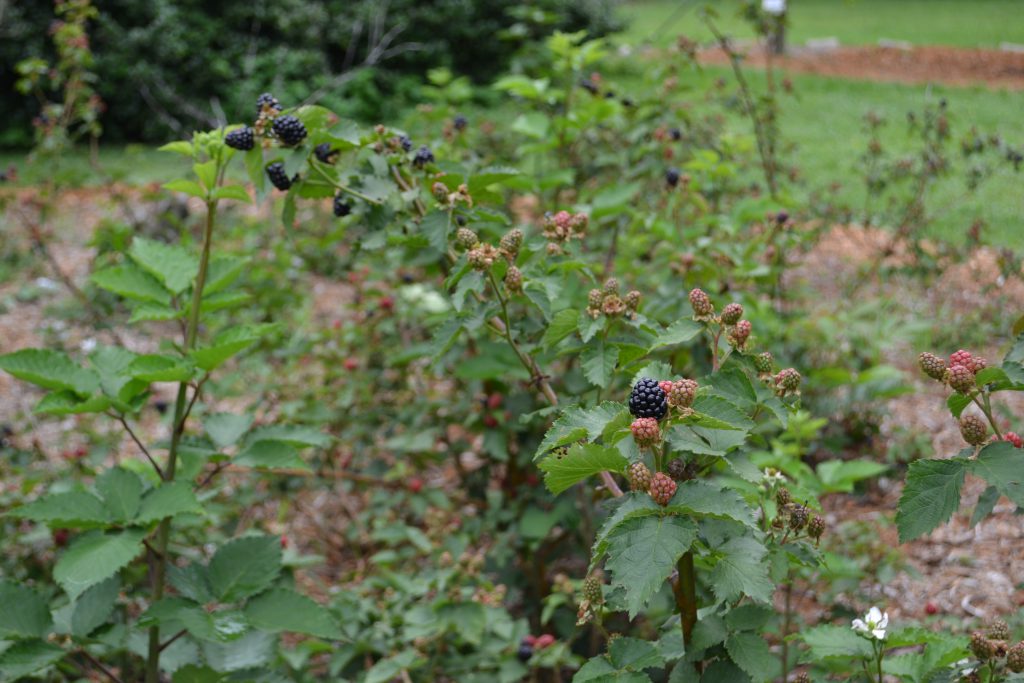
Arapaho blackberry has chill requirements that match those received in our area. Photo by Beth Bolles, UF IFAS Extension
Many of us are enjoying warmer temperatures this winter, but many deciduous fruit crops really need cold temperatures in order to break dormancy for the year. In areas that experience cold temperatures, plants have evolved the ability to survive by slowing growth and protecting sensitive tissues by going dormant. In order to break out of dormancy and begin growth again, plants experience an amount of chill hours (temps between 32 and 45 degrees F) that is suitable for specific areas. In our area, we normally range between 400 and 600 chills hours.
If we choose a fruit plant whose chill requirements match the amount of chill in our area, the plant will generally resume growth when it is safe for buds and tender tissues to develop. If we choose a plant with chill requirements higher than the amount our area receives, then the plant is not signaled to break dormancy and we end up with very sparse growth and no fruit.
So far in the winter of 2016-17, some areas have not received ‘normal’ amounts of chilling temperatures. Common fruit like apple, peach, some blueberries, and certain selections of blackberries may be affected by this by not breaking out of dormancy. This can impact your flower and fruit formation. For commercial growers, it can impact the amount of fruit available and even fruit prices at markets.
Since fruit trees are an investment of time and money, these are not plants that can be easily replanted to match chill hours with changing weather patterns. Perhaps planting fruit crops with a range of chill hours required might be beneficial Your future decisions to grow fruit trees may include crops that don’t rely as much on chill hours to be successful. For more information, please consult the Dooryard Fruit Varieties guide from UF / IFAS Extension.
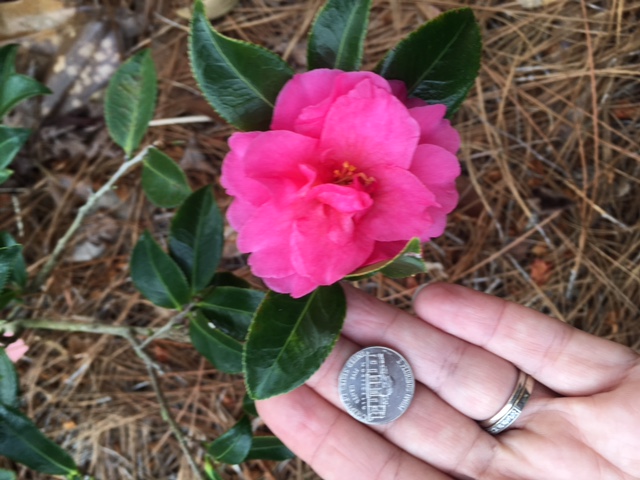
by Julie McConnell | Jan 17, 2017
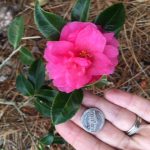
Winter flowers and small leaves with serrated edges lead to identification as Camellia sasanqua. Photo: J_McConnell, UF/IFAS
A common diagnostic service offered at your local UF/IFAS Extension office is plant identification. Whether you need a persistent weed identified so you can implement a management program or you need to identify an ornamental plant and get care recommendations, we can help!
In the past, we were reliant on people to bring a sample to the office or schedule a site visit, neither of which is very practical in today’s busy world. With the recent widespread availability of digital photography, even the least technology savvy person can usually email photos themselves or they have a friend or family member who can assist.
If you need to send pictures to a volunteer or extension agent it’s important that you are able to capture the features that are key to proper identification. Here are some guidelines you can use to ensure you gather the information we need to help you.
Entire plant – seeing the size, shape, and growth habit (upright, trailing, vining, etc.) is a great place to begin. This will help us eliminate whole categories of plants and know where to start.
Stems/trunks – to many observers stems all look the same, but to someone familiar with plant anatomy telltale features such as raised lenticels, thorns, wings, or exfoliating bark can be very useful. Even if it doesn’t look unique to you, please be sure to send a picture of stems and the trunk.
Leaves – leaf color, size and shape is important, but also how the leaves are attached to the stem is a critical identification feature. There are many plants that have ½ inch long dark green leaves, but the way they are arranged, leaf margin (edges), and vein patterns are all used to confirm identification. Take several leaf photos including at least one with some type of item for scale such as a small ruler or a common object like a coin or ballpoint pen; this helps us determine size. Take a picture that shows how leaves are attached to stems – being able to see if leaves are in pairs, staggered, or whorled around a stem is also important. Flip the leaf over and take a picture of the underside, some plants have distinctive veins or hairs on the bottom surface that may not be visible in a picture taken from above.
Flowers – if flowers are present, include overall picture so the viewer can see where it is located within the plant canopy along with a picture close enough to show structure.
Fruit – fruit are also good identification pictures and these should accompany something for scale to help estimate size.
Any additional information you are able to provide can help – if the plant is not flowering but you remember that it has white, fragrant flowers in June, make sure to include that in your description.
Learning what plants you have in your landscape will help you use your time and resources more efficiently in caring for you yard. Contact your local UF/IFAS Extension office to find out who to send requests for plant id.
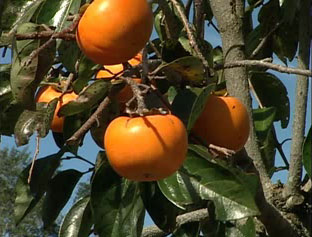
by Matthew Orwat | Oct 21, 2016
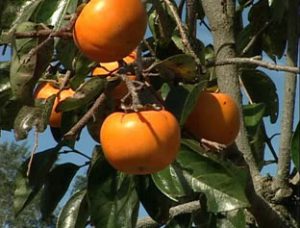
Image Credit: gardeningsolutions.ifas.ufl.edu
A recent visit to the North Florida Research and Education Center reminded me of a fruit that is often low profile in Northwest Florida, the Oriental persimmon. The Oriental, or Japanese, persimmon (Diospyros kaki) was introduced to the Southern United States in the mid to late 1800s. Although it is native to Japan and China, it is a close relative of the native persimmon Diospyros virginiana.
In the early 20th century the oriental persimmon was a popular fruit crop in Florida, but this industry declined due to marketing factors. The Oriental persimmon is still a viable fruit for home gardens.
Trees are available grafted onto local native persimmon rootstock, which enhances their ability to perform well in Northwest Florida soils.
Persimmons are divided into two types for the purposes of marketing: astringent and non-astringent. Astringent persimmons contain high concentrations of tannins which cause the mouth to pucker when eating the persimmon if it is not fully ripe. When fully ripe, they are rich and sweet, but very soft. Non-astringent cultivars can be picked hard and ripened for 7-10 days at room temperature. Non-astringent persimmons were developed in Japan and introduced to the U.S. market in the 1980s. These have become very popular with home gardeners since they can be eaten when firm, and have a crunchy texture. Persimmons are popular today in Asian cuisine and as a dessert, since they contain sugars at levels between 15 and 25%.
Persimmons have relatively few pests in Northwest Florida when compared to other higher maintenance fruits such as peaches and plums. Fungal leaf spot caused by species of cercospora, alternaria and anthracnose can cause premature defoliation. Fungicidal sprays are useful in controlling these diseases if they are at high enough levels to cause tree injury. The stem and branch fungus Botrysphaeria dothidia will cause deep, elongated branch lesions similar to canker. These openings invite borers into the tree and can lead to loss of the limb structure. The best defense against this problem is a good offense; a healthy tree will be less likely to be attacked by this fungus. Dormant sprays of copper or sulfur based fungicides can also help reduce the incidence of all fungal diseases.
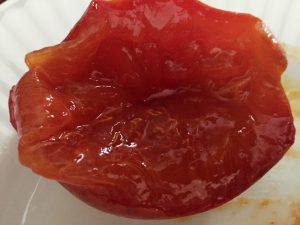
Fully ripe persimmon, ready for a scoop of ice cream! (Image Credit Matthew Orwat)
The major insect pest of persimmon is scale. Thankfully, scale can be controlled with dormant oil or season all horticultural oil. Persimmon psylla can cause leaf deformation early in the season, but is not always a large enough problem to warrant control. Natural enemies often eliminate the need for chemical control. If control is necessary, several insecticides labeled for fruit trees will take care of the problem. Twig girdlers can lay eggs on persimmon stems in September and October, and once hatched, the insect can girdle the stem and the stem will die. To control this pest it is important to remove dead and infected wood each growing season.
Out of the non-astringent cultivars, Fuyu regularly rates as the most popular and reliable cultivar. It does require thinning, since it often sets too much fruit, which can cause branches to bend and break. A good practice is to thin out 50% of the fruit during years in which fruit set is heavy.
Below is a chart of different non-astringent persimmon cultivar characteristics from the IFAS Extension publication SP 101, from April 1994 by E.P. Miller, Biologist; T.E. Crocker, Professor, Horticultural Sciences Department, Cooperative Extension Service, Institute of Food and Agricultural Sciences, University of Florida.
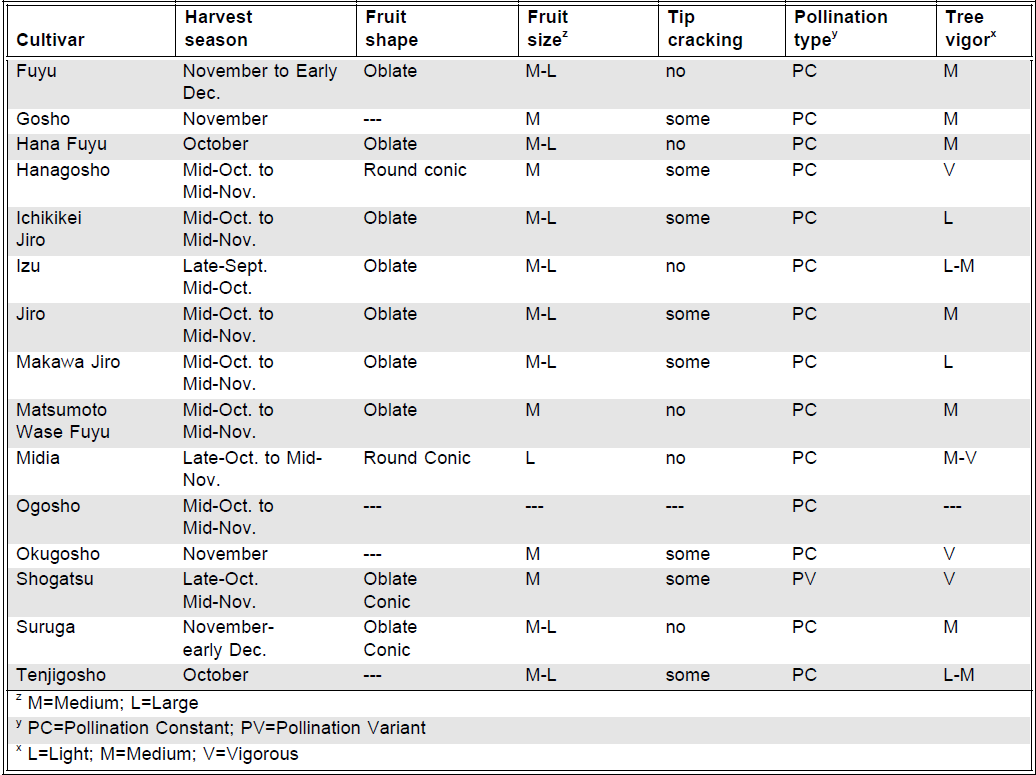
Characteristics of non-astringent cultivars. SP 101, from April 1994 by E.P. Miller; T.E. Crocker,
For further information please consult the UF / IFAS publication ENH 388: Diospyros kaki: Japanese Persimmon and the previous Panhandle Agriculture article Oriental Persimmon Varieties for North Florida .

by Ray Bodrey | Jul 5, 2016
It’s safe to say that almost everyone equates citrus with the state of Florida. It just goes hand in hand. Most people first think of citrus as being oranges and grapefruit. Even by traveling south on I-75 or I-95, our welcome centers will gladly supply you with a complimentary cup of the juice of your choice, orange or grapefruit. However, the kumquat is a fruit that rarely comes to mind. The Panhandle is prime habitat for this forgotten fruit.
The kumquat is a native of southeast China, but it has found a home on the Gulf coast. It’s a cold hardy citrus, much like the Panhandle favorite satsuma orange. Due to the plants ability to be semi-dormant in the region, the kumquat has been known to withstand temperatures in the low teens. The kumquat fruit is an oddity in the citrus world. The peeling is sweet, the pulp is tart and it’s all edible, except for the seeds of course. The fruit reaches maturity around October, and will remain viable on the tree until March.

Figure 1: Kumquat fruit: Nagami variety.
Credit: UF/IFAS.
There are two varieties grown in Florida. The Nagami (Fortunella margarita) is by far the most popular in the state. This variety has oval shaped fruit and 2-5 seeds. The Meiwa (Fortunella crassifolia) has a more rounded shaped fruit with almost no seeds. This variety’s fruit is more sweet and juicy compared to the Nagami.
Kumquat is one of the easiest fruits to grow in the Panhandle. Most gardeners enjoy the ease of management as the kumquat tree is relatively small in size, and requires much less care compared to other citrus. Another advantage to kumquats is the ability to be grown in containers. Also, the dark green leaves and orange colored fruit is quite appealing on your back deck or patio.
When planting a kumquat, make sure the location has plenty of sunshine. Always apply mulch, but be sure to keep the mulch at least a foot from the trunk to combat any potential of disease. As for container growing, be sure to purchase a large container with adequate drainage holes. Place a screen in the bottom of the container, rather than rocks. This will ensure no soil is lost during drainage events. Newly planted kumquats will need significant water on a regular basis to become established, especially if planted in a container. Once established, watering can be limited.
Kumquats will need a fertilizer regimen too. A citrus formulated fertilizer works great. Although not required, pruning should be done after April or later in the summer before new flowers appear. A major plus, kumquat trees generally bear fruit just after a couple of years.
Kumquats are a delight to grow in the Panhandle and a fantastic evergreen for your landscape, back deck or patio.
Supporting information for this article can be found in the UF/IFAS EDIS publication, “Fortunella spp., Kumquat” by Michael G. Andreu, Melissa H. Friedman, and Robert J. Northrop & “Get Acquainted with Kumquat” by BJ Jarvis, CED & Horticultural Agent, UF/IFAS Pasco County Extension:













